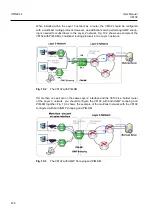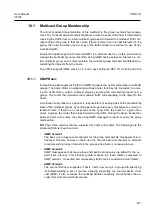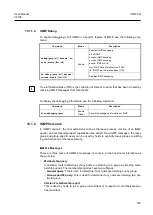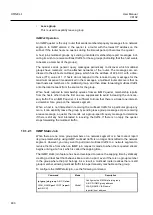
User Manual
UMN:CLI
V8102
465
To display the configured system flood guard, use the following command.
Command
Mode
Description
show system-flood-guard
Enable
Global
Shows the configured system flood guard.
BPDU is still transmitted even if the specific port is blocked by system flood guard.
9.11.4
Invalid Traffic Guard
A packet storm may occur unexpectly if a large number of invalid packets are received on
a port. It can cause the network to slow down or to time out. The V8102 provides the traf-
fic guard function that controls the
port’s traffic by threshold value. The threshold (%) rate
is based on the number of packets per second (pps). Basically, a maximum pps is usually
calculated when all Ethernet frames are of 64-bytes in length, or the minimum size frame.
Because of the Inter-Packet Gap (12 bytes) and preamble (8 bytes), the minimum packet
size becomes 84 bytes.
The following table shows the performance numbers in packets per second (pps) for
100M, 1G and 10G Ethernet port.
Port Speed
Bytes/second
PPS for 64-byte
PPS for 1518-byte
100M Port
12,500,000
148,809
8,234
1G Port
125,000,000
1,488,095
82,345
10G Port
1,250,000,000
14,880,952
823,451
The invalid traffic guard function is configured with the threshold rate (%) that is based on
pps of the maximum Ethernet port
’s bandwidth.
Frame size for
PPS calculation
Packet Type which are
counted
Threshold Rate (%) based on
PPS
Attack-guard
64-byte
Multicast, Unicast, Broad-
cast
1G port: 100% (=1,488,095 pps)
10G port: 100% (=14,880,952 pps)
Default: High-80%, Low-20%
Error-guard
64-byte
Error packets
1G port: 100% (=1,488,095 pps)
10G port: 100% (=14,880,952 pps)
Default: 1%
To generate a SNMP trap of invalid traffic guard (attack/error), SNMP trap mode should
be
“alarm-report” mode.
9.11.4.1
Attack Guard
A packet storm may unexpectedly occur if a large number of broadcast, unicast, or mul-
ticast packets are received on a port. Forwarding these packets can cause the network to
i
i
















































